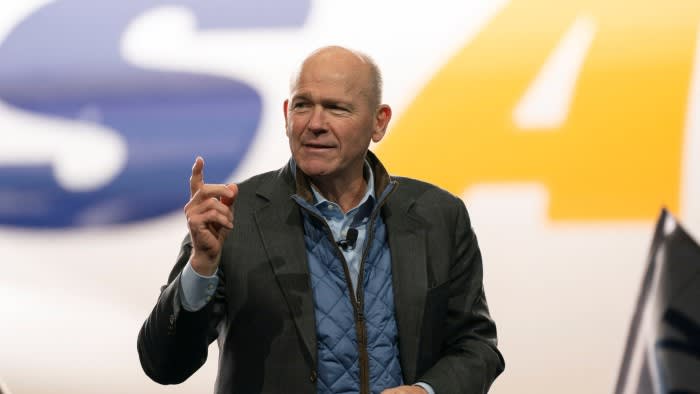Unlock the Editor’s Digest for free
Roula Khalaf, Editor of the FT, selects her favourite stories in this weekly newsletter.
Boeing chief executive Dave Calhoun is to step down at the end of the year as the US aircraft manufacturer struggles to contain a crisis over its safety standards following the mid-flight blowout of a door panel.
Boeing said on Monday that its chair Larry Kellner would also leave the board after the company’s annual shareholders’ meeting in May. He will be replaced by former Qualcomm chief executive Steve Mollenkopf, who will lead the search for Calhoun’s successor.
Stan Deal, head of the company’s commercial aeroplane division, which has been at the centre of the door-plug incident, is to retire immediately, Boeing added. He will be replaced by chief operating officer Stephanie Pope.
The management shake-up caps weeks of turmoil for the group after a door panel blew out mid-air during an Alaska Airlines flight in January.
The accident, which involved Boeing’s 737 Max 9, is being investigated by the US Department of Justice, the National Transportation Safety Board and the US Federal Aviation Administration.
The company has had to slow production of the 737 Max as it sought to resolve manufacturing flaws and some airlines have had to amend their flight schedules because of delays in deliveries of Boeing aircraft. Last week Boeing warned it would burn more cash in the first quarter than previously expected because of the crisis.
Boeing shares were up 1.5 per cent on Monday. They have decreased 23 per cent to $191.40 in the wake of the door-panel incident, giving the company a market value of $116.8bn.
Robert Stallard, analyst at Vertical Research Partners, said the changes were “probably a wise move by the Boeing board of directors . . . [given that] many of its customers, suppliers and other stakeholders have arguably lost faith in the company”.
In an internal memo sent to employees on Monday, Calhoun, 66, described the January accident as a “watershed moment” for Boeing. The company “must continue to respond to this accident with humility and complete transparency”, he said.
Calhoun had been “considering for some time, in discussion with our board of directors, the right time for a CEO transition at Boeing”, he explained, adding: “I will only feel the journey has been properly completed when we finish the job that we need to do.”
The decision to retire was “100 per cent” his, Calhoun told CNBC, adding that he was entering his fifth year at Boeing and getting “close to 68” by the end of this year. He was giving the board “plenty of notice” to plan his succession.
The shake-up was “a partial step towards changing [Boeing’s] culture to underscore safety and rebuild investor confidence”, said TD Cowen analyst Cai von Rumohr in a note. The fact that the board has until the end of the year to find a new chief executive “likely is a plus” because “it provides leadership continuity, which a knee-jerk change would not”.
Boeing’s biggest airline customers had criticised the manufacturer’s production problems and quality lapses following the Alaska Airlines accident. Several airline chief executives had requested meetings with Boeing’s board of directors this week. Mollenkopf would now attend those meetings, said people familiar with the situation.
Ryanair chief executive Michael O’Leary, who has an order book of 400 Boeing aircraft, welcomed the changes at the top of Boeing’s commercial business, which he said he hoped would help to “eliminate Boeing’s delivery delays”.
Southwest Airlines, which flies only Boeing jets, said it “is committed to working with Boeing’s new leadership team”, and Delta Air Lines also pledged to “remain closely engaged” with the manufacturer to ensure planes met quality and safety standards.
Calhoun, who has sat on Boeing’s board since 2009, replaced Dennis Muilenburg as chief executive four years ago in the wake of two crashes involving the 737 Max 8 in 2018 and 2019 that killed a combined 346 people.
The planes had a flawed flight-control system, which was designed to push the nose of the plane down when necessary to prevent it from stalling. However, it was connected to just one sensor and so was vulnerable to erroneous readings that could prompt dangerous downward corrections.
The company paid more than $2.5bn to defer criminal prosecution by the DoJ for misleading aviation regulators. Prosecutors agreed to ask the court to dismiss the case in three years if Boeing adhered to a compliance programme. But the Alaska Airlines door panel blew off shortly before the agreement was set to expire.
Additional reporting by Philip Georgiadis
This article has been updated to clarify the fault in the 737 Max 8

